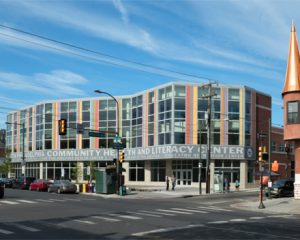By Elizabeth Devietti, MPH and Dalton Paxman, PhD, Office of the Assistant Secretary for Health, Region III, U.S. Department of Health and Human Services

In 2012, the Children’s Hospital of Philadelphia (CHOP) began a partnership with the City of Philadelphia to create a unique space to serve South Philadelphia residents that innovatively combined health care, literacy, and recreation. In May 2016, the doors to the state-of-the-art, 96,000-square-foot South Philadelphia Community Health and Literacy Center opened, granting local residences access to an advanced medical clinic, outdoor playground, and fully stocked library with a wealth of information and services.
This public/private partnership was unprecedented in Philadelphia, not only in the array of services offered at a single location, but also in its financing. The project budget of $42.7 million was funded with $2.2 million from the City of Philadelphia, $32.5 million from CHOP financing/sponsor equity, and $8.0 million from New Market Tax Credits equity funds. New Market Tax Credits (NMTC), a program managed by the U.S. Treasury Department described as a “catalyzing source of development funds,” helps attract private capital into low-income communities by allowing investors to receive federal income tax credits in exchange for investing in struggling local economies. The South Philadelphia Community Health and Literacy Center is an example of a growing number of projects of this kind and demonstrates the link between community development and health.
According to Robert Wood Johnson Foundation and Center for Social Disparities in Health, community development aims to improve disadvantaged neighborhoods by developing and financing activities that revitalize communities, such as affordable housing, grocery stores, health clinics, and schools. Neighborhoods represent more than just a clustering of residents. The physical conditions, services available, and social conditions of neighborhoods are “repeatedly and strongly linked to mortality, general health status, disability, birth outcomes, and chronic conditions.” In acknowledgement that zip codes play a bigger role in determining our life span than our genetic code, the fields of community development and public health can join forces by utilizing the capital generated from community development and the best practice research and evaluation skills from public health to foster new funding opportunities and promote sustainable change in neighborhoods that need it most.
In Philadelphia, the community development sector has taken note and is beginning to intentionally address health concerns through projects like the Community Health and Literacy Center. This requires going beyond addressing individual health promotion to focus on social and economic circumstances that shape health.
But we all know there is no silver bullet when it comes to fostering healthy neighborhoods. Investing in quality development, design, and planning is a start. Involving public health experts to evaluate the efficacy of built environment interventions is a strong next step. However, it is only through continued dialogue and persistent inter-organizational cooperation that policy and action can achieve our ultimate goal of health for all.